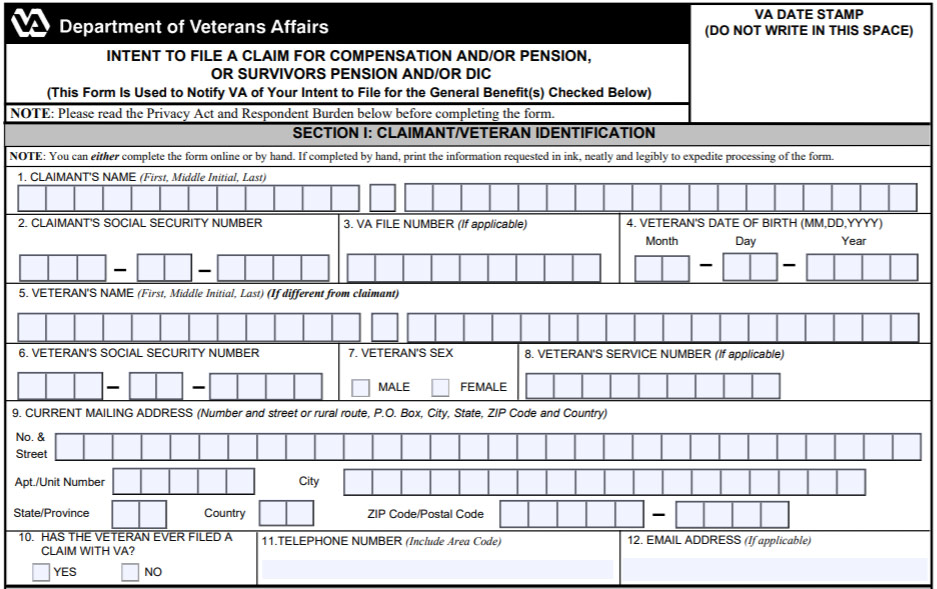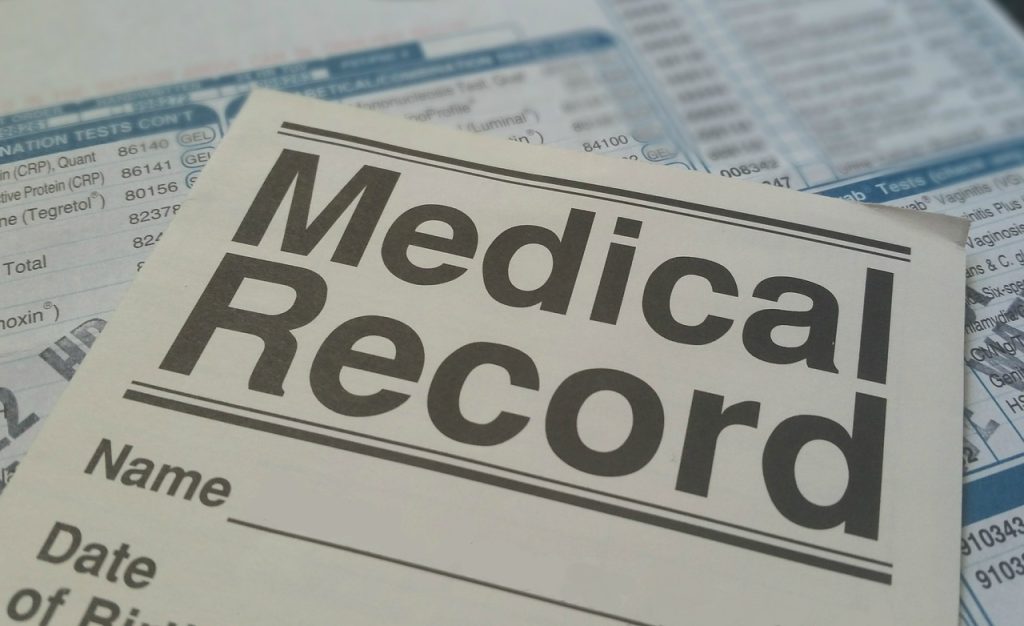Table of Contents
If you plan to file a VA claim for disability or pension benefits, you should consider submitting a VA Intent to File as soon as possible. While the Department of Veterans Affairs does not require the Intent to File, it is an important first step in the VA disability claim process and provides many benefits for the applicant.
4 Benefits of the VA Intent To File
- Maximizes back pay compensation
- Buys you time to gather evidence
- Helps avoid unnecessary appeals down the road
- Easy to fill out and submit
It’s no secret that filing a successful VA disability claim can be a challenge. Using the VA Intent to File can simplify the process and significantly improve your chances of getting a favorable decision from the VA. Even if you’re not planning on filing a claim right now, it’s still a good idea to submit an Intent to File because it will hold your start date if you decide to apply in the future.
The Intent to File is a one-page document that requires just a few pieces of information. Claimants have four convenient options to deliver the form: online, through the mail, in person, or over the phone.
While it doesn’t take much effort to submit the Intent to File, it can save you a great deal of time in the long run. You have one full year from the date you file to gather your information to complete your compensation application. The security of the Intent to File ensures you won’t have to rush through doctor appointments, forget to include relevant evidence, or make sloppy mistakes on documents.
Your goal is to receive compensation that accurately depicts each condition incurred or aggravated during your military service. To do that, you’ll need a detailed application packet that is free from errors. The VA Intent to File gives you peace of mind to compile a high-quality application packet.
What Is a VA Intent to File?
Previously known as an “informal claim,” the VA Intent to File is a form submitted to notify the VA that you plan to apply for veterans disability benefits or survivor benefits. It starts the claim process by opening a record and establishing an effective date. If your claim is approved, this date determines how many months of back pay you are entitled to receive.
You can submit an Intent to File through the eBenefits website, by mailing the form to your regional office, or by speaking to a VA representative in person or on the phone. If you have someone helping you, such as a Veterans Service Officer, they can contact the VA on your behalf and submit the information for you. The form is easy to complete and will ask for some basic personal and contact information.
Once the Intent to File is submitted, claimants have one year to file the complete claim. Now you have ample time to gather relevant evidence such as medical records, military service records, and the application form. Submitting a detailed and error-free claims application the first time is essential to a smooth VA claims process.
If you plan to file more than one VA claim, you will need to file a separate Intent to File for each claim.
Even if you are not planning to file a new VA claim, it’s still a good idea to submit a VA Intent to File. If an opportunity comes up during the next 12 months, you’ve already opened the file and are even more prepared. If you don’t end up filing a claim, the Intent to File expires, and there’s no harm done.
What Is an Effective Date?
The date your benefits claim process begins is the effective date. If using the Intent to File process, the effective date is when the VA receives your Intent to File form. If you submit a claim without first submitting an Intent to File, the effective date is the date your claim application is received.
Once your claim is approved, the effective date becomes the starting date for compensation. The VA pays retroactive benefits back to the effective date, which is why it is essential to establish it as early as possible.
Submitting a VA Intent to File will lock in this date. A VA employee will log the receipt of your form, and that will become the effective date.
It can take months to put together a complete disability claim, especially if you are still attending doctor’s appointments for the condition. Even after you have turned in your application, the VA will take time to decide. You may have to attend a C&P exam for a medical evaluation. Submitting an Intent to File helps ensure you will receive compensation for the entire time it takes to process your claim.
4 Benefits of the VA Intent To File
We have all heard stories about how hard it is to get a VA claim through the red tape of approval. The VA Intent to File process gives applicants several benefits that help with the overall claims process.
1. Maximizes Back Pay Compensation
Anchoring your effective date is the key to getting the maximum amount of disability compensation. The VA uses the effective date to calculate how many months of back pay you will receive when your VA claim is approved.
Here is an example to follow. You submit your Intent to File, and the VA gives you an effective date of October 8. You continue the process of putting together your claim over the next several months. To put together a solid packet, you’ll be attending doctor appointments, getting witness statements, and making copies of your military service records. Now your claim application is ready, and you submit the completed application on July 30. The VA reviews your disability claim and approves it on September 1. You will receive about 11 months of back pay because of your Intent to File.
The Intent to File process allows veterans to be compensated while preparing the best application they can to communicate the service-connected disabilities that have resulted from their military service.
2. Buys You Time to Gather Evidence
A detailed, error-free claim application with relevant evidence is a critical part of getting your disability or pension claim approved. You do not want to rush, make mistakes, or miss out on including conditions that could increase your rating. You will need to get copies of medical records, military service records, witness statements, and other official documents. All of this can take lots of time and energy, even if you have a Veterans Service Officer who helps you with the process.
For surviving spouses, grief can be a debilitating time when filing for death pension benefits is the last thing on their minds. But financial burdens can also add pressure to families when a veteran has passed away. Completing an Intent to File is a way to start the process while giving the surviving spouse time to complete the claim when they are ready.
You want to get a favorable decision from the VA the first time you file. Having an Intent to File in place that locks in your effective date will give you the peace of mind to be thorough and accurate in completing your claim application.
3. Helps Avoid Unnecessary Appeals Down the Road
If you don’t get a favorable decision and your claim is denied, all is not lost. You can appeal the VA’s decision. But that will undoubtedly extend the length of time for the process and the time you are not receiving compensation.
The odds of winning an appeal are not great. In 2020, only 33% of appeals were approved. By having the security of an Intent to File in place, you will be free to take your time and develop a carefully detailed claims packet.
Similar to filing an appeal, you may need to file a supplemental claim if new evidence comes along to support your case. The Intent to File process helps protect against supplemental claims because you can use the full extent of those 12 months to discover any new evidence that may come up.
4. Easy To Fill Out and Submit

The one-page VA Form 21-0966 is easy to fill out and submit. The first part of the form asks for general information to include:
- Name
- Social Security Number
- Date of Birth
- Mailing Address
- Phone Number
- Email Address
If a surviving spouse is completing the form, they will include their personal information along with the veteran’s personal information.
The next part of the form is the General Benefit Election section. Here you will indicate which benefit you plan to submit a claim for compensation, pension, or survivors’ pension or dependency and indemnity compensation.
The claimant or authorized representative must sign and date the form. An authorized representative such as a Veterans Service Officer or Casualty Assistance Officer can submit your Intent to File on your behalf as long as you permit them.
How to Submit an Intent to File
The VA has set up three ways to submit your Intent to File to make the process accessible to all veterans and surviving spouses. The quickest method to submit is by entering the information into the online form on the eBenefits website. The VA receives your form instantly, and the effective date will be the same day.
You can also mail the paper form to your local VA Regional Office. Most likely, the VA will receive it in a few days, and the date they receive it will be your effective date.
If neither of those options works for you, you can call a VA representative and give the information over the phone. You can also speak to a representative in person at your local VA office.
Understanding the VA Intent to File
The VA Intent to File process is a valuable tool for veterans to use when submitting a claim for compensation and pension benefits. Disability claims can be complicated, taking several months to gather all the necessary documentation and records. Submitting an Intent to File locks in the earliest effective date possible. This not only buys you time but maximizes the amount of back pay you can receive.
Since you’ll have time to prepare your claim carefully, you may discover new conditions or secondary conditions related to your military service that you weren’t initially planning to claim. Having this time ensures you will receive the full extent of your benefits.
The VA Intent to File is quick and easy to file, and it will also save you tons of time you could be wasting on appeals and supplemental claims. If you file online, your record will be opened in just a few minutes. Take time today to get the ball rolling on your claims process and lock in your effective date with the VA Intent to File.


